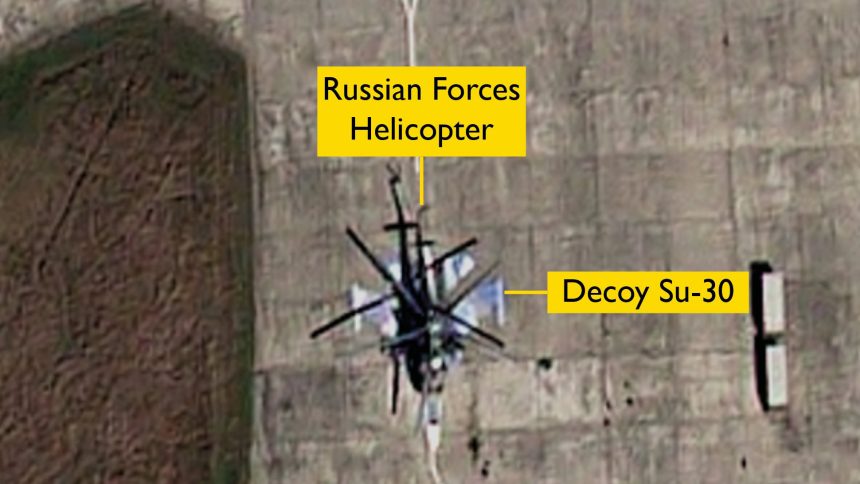Russian helicopters are disrupting Moscow’s efforts to deceive Ukraine using decoys, by landing on the dummy fighter jets painted on the concrete.
In September 2023, satellite imagery of Engels-2 airbase, located in Saratov Oblast, some 400 km southeast of Moscow and roughly 700 km from the border with Ukraine, exposed a certain number of Russian Aerospace Forces Tu-95 Bear and Tu-160 Blackjack bombers with their wings and part of the fuselage covered with car tires. Another image, taken from the ground at an unknown airfield and circulated online more or less one week after the images from Engels first appeared online, showed a Sukhoi Su-34 Fullback bomber with tires on the fuselage, wings and horizontal stabilizers.
The reason for the presence of car tires on the top of the aircraft has long been debated and many theories were formulated: according to Ukrainian sources, the tires were being used as a sort of makeshift protection from attacks carried out with kamikaze drones. Others suggested the bombers were retired airframes being used as decoys to get possible strikes away from operations aircraft, or to make radar targeting by Ukraine’s long-range missiles harder (a theory backed by the fact that the tire cover on the Tu-95 was observed altering the synthetic aperture radar signature of the bomber).
On Sept. 10, 2023, the popular FighterBomber Telegram channel, with close ties with the Russian Aerospace Forces’ aircrews, posted some new images, showing what was described as an anti-drone structure being fielded for test purposes at an unspecified Russian airfield.
Those mentioned above were just two “creative” ways apparently put in place by Russia to mislead the deadly Ukrainian attack drones.
But they were not the only ones.
Besides inflatable tanks and wooden rocket launchers, in January 2024, an image captured by Planet Labs PBC and obtained by Business Insider showed the silhouette of a combat aircraft painted on the tarmac of Mozdok Air Base in southeast Russia. Similar decoys, painted some time between the summer and fall 2023, have been exposed by satellite imagery of Belbek, Gvardeyskoye and Krymsk Air Base.
The reason for using such decoys is always the same: deceive the Ukrainian drones that rely on basic cameras for image recognition of aircraft shapes.
As Ukrainian long-range strike capabilities have grown, so has the number of decoys at Russian air bases involved in the invasion of Ukraine.
This thread shows several of the decoys Russian forces have painted at air bases that were once beyond Kyiv’s reach. (1/8) pic.twitter.com/Yy68uZykRw
— Brady Africk (@bradyafr) January 30, 2024
While this tactic, that is nothing new, has likely helped prevent some of the Ukrainian attacks, it would appear to be undermined, on some bases, by an internal “threat”.
According to the UK MOD Defence Intelligence update dated Apr. 2, 2024, Russian helicopters “still regularly land on the painted decoy fighter silhouettes, completely undermining the deception attempt”
Latest Defence Intelligence update on the situation in Ukraine – 02 April 2024.
Find out more about Defence Intelligence’s use of language: https://t.co/VLI1JhTxbL#StandWithUkraine 🇺🇦 pic.twitter.com/rGi9A7DqCR
— Ministry of Defence 🇬🇧 (@DefenceHQ) April 2, 2024
The satellite image of the Kirovskoe base shows this: a Russian Ka-52 Alligator helicopter sitting directly on the silhouette of a Su-30 jet. “This also reveals the true order of battle or aircraft strength at these airbases, which Russia is likely trying to mask from Ukraine’s intelligence picture,” the British MOD says.









